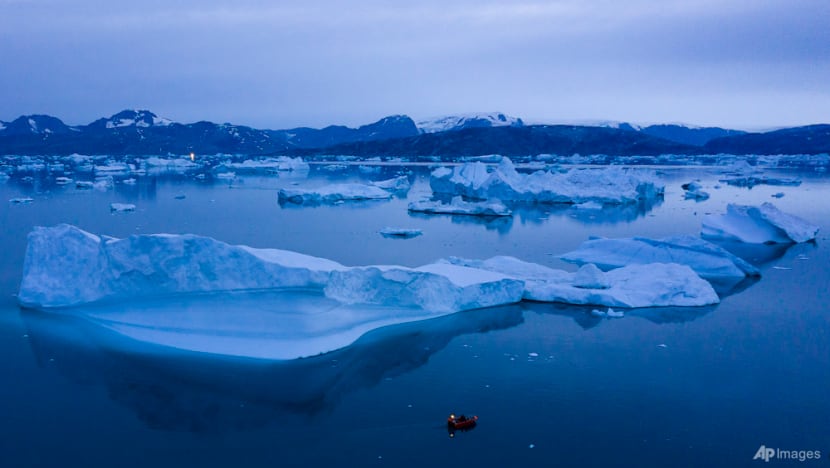Commentary: Sea curtains and glass beads? Zany climate ideas show how far off track we are
Some proposals for climate cooling would require unprecedented levels of global cooperation and feats of engineering, says Lara Williams for Bloomberg Opinion.

A boat navigates large icebergs near Kulusuk, in eastern Greenland, on Aug 15, 2019. (AP Photo/Felipe Dana, File)
LONDON: The worse things get for the planet, the more unworkable the suggestions to save it become.
Exhibit A comprises proposals for climate cooling interventions focused on the polar regions, which are particularly vulnerable to climate change. The Arctic, for instance, warmed nearly four times faster than the rest of the globe between 1979 and 2021. Given that the poles help moderate the Earth’s temperature by reflecting large amounts of solar radiation back into space, as well as store an awful lot of freshwater in their enormous ice sheets, climate consequences in the Arctic and Antarctica will be felt around the world.
We know what we need to do to protect these regions: Reduce our dependence on fossil fuels.
Yet some of the proposed methods, which would instead seek to treat the symptoms rather than the cause, may actually put the cold ends of the planet at greater risk, and would require unprecedented levels of global cooperation and feats of engineering beyond anything we’ve seen before.
A WHOLE RANGE OF UNINTENDED CONSEQUENCES
Take, for instance: sea curtains. The idea involves installing artificial structures to keep warm water reaching the Antarctic and Greenland ice sheets, thus preventing glacier melt and sea-level rise.
The Seabed Curtain project, a research programme led by the University of the Arctic, envisions an 80km-long structure anchored to the seabed, 650m deep, with 150m-tall curtains (made from as-yet undetermined material).
Sounds pretty ambitious, but you don’t know the half of it. A paper published in Frontiers In Science highlights the dangers of a number of proposed polar geoengineering methods, including sea curtains.
The authors note that installing infrastructure at depth on various different seafloor surfaces is extremely challenging even before you’ve taken into consideration the harsh environment and remoteness. Access to the building site may only be possible for a few months each year, and even then, conditions remain difficult with 56 per cent of cruises to the area experiencing at least partial disruption or difficulty entering or exiting the area.
It would not be cheap – some scientists estimate that an 80km divider in West Antarctica would cost at least US$80 billion – and may cause a whole range of unintended consequences, such as the disruption of marine life and redirection of warm water elsewhere, which could speed the melting of an adjacent glacier. Not to mention the construction and installation of the behemoth structure would release huge amounts of carbon emissions.
Other proposals examined include the release of hollow glass beads over first-year Arctic ice to increase the amount of solar energy it reflects and increase its survival chances. The Arctic Ice Project, a US-based research initiative, recently shut down after tests showed that its tiny silica orbs posed a risk to the Arctic food chain. As well as these toxic effects on biodiversity, it’s worth noting that for the plan to work, we’d need to produce 360 megatonnes annually, an amount equivalent to the annual global production of plastic.
DISTRACTING US FROM WHAT IS NEEDED
The review led by Martin Siegert, glaciologist and deputy vice chancellor at the UK’s University of Exeter, examined methods including thickening sea ice (an approach that would require 100 million seawater pumps to cover the whole Arctic), stratospheric aerosol injection (in which something like sulfur dioxide is sprayed into the atmosphere to partially block sunlight) and ocean fertilisation.
The conclusion for all of them is that they are environmentally dangerous and cannot be deployed in time to address the symptoms of climate change. The authors write “that further research into these techniques would not be an effective use of limited time and resources” and such ideas could distract us from the urgent need to decarbonise.
The paper has been criticised by some for being one-sided, with many pointing out that we’re already facing environmental damage without geoengineering. That’s true, but it is also already apparent that the benefits of some of these techniques are unlikely to outweigh the vast costs.
It does raise an awkward question regarding geoengineering in general, however: At what point should research be halted?
We are in a strange position, where the UK government’s official stance, reiterated in an Environmental Audit Committee report on the UK and the Antarctic environment, is that it “is not in favour of Solar Radiation Management,” while it has committed more than £56 million (US$76 million) toward research into that very area. Is that hypocritical, wasteful or prudent?
As long as experiments meet strict ethical criteria, like the one laid out by the American Geophysical Union, we should endorse the pursuit of scientific knowledge. The necessary debate ahead of us is a delicate one that balances the relative risks of geoengineering approaches with the dangers of climate change. Difficult discussions will be made easier with rigorous, transparent research – both into climate interventions and the understudied polar regions themselves.
They’ll also be made simpler with an unwavering commitment to decarbonisation. After all, the less we pollute, the less need there’ll be for climate cooling interventions in the first place.











